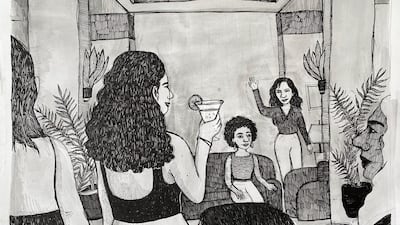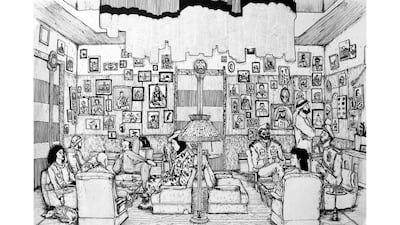Set to open in November, The Arts Club Dubai is the latest player to join the UAE arts scene.
It is the first international outpost of the famed private members’ club in London, which has been running since 1863 and names authors Charles Dickens and Anthony Trollope as its co-founders.
Located in DIFC, The Arts Club Dubai is spread across four floors, boasting a library, events space and nightclub, as well as private dining rooms and lounges. It aims to follow in the footsteps of its Mayfair progenitor with its own cultural programme and art collection.
Its target audience is specific: the cultured elite who have the means to pay for the club's annual membership fees, which can go up to Dh15,000, and to spend money at its many restaurants and bars.
But will it actually be a boost for the arts?
As part of its mission, The Arts Club Dubai will host exhibitions and cultural events for its members while working with local and regional artists, galleries and creators for its programming.
“We can create that bridge for people who might not naturally be exposed to what is going on culturally and creatively, and then connect them to creatives and artists, whether it be through commissioning, exhibitions, grants, talks or workshops,” says Sybel Vazquez, head of cultural programming at the club.
The institution's main role is to act as a go-between for members and potential patrons in the region looking to build their cultural knowledge, but do not quite know how. In turn, selected artists and creatives will have a new platform to showcase their work, which could lead to commissions and sales.
Last month, the club announced its inaugural commissions programme, with Vazquez inviting four emerging artists in the UAE to create illustrations that will be displayed in the space. The works by Faisal Elmalak, Rama Duwaji, Salama Nasib and Sultan Al Ramahi imagine members socialising against the backdrop of the club's plush interiors.

Vazquez adds that The Arts Club Dubai’s reach expands beyond the visual arts to include literary, culinary and performance arts. “There’s this notion that the arts is one thing when it really can be across the board. It can be culinary art. It can be film. There are so many artists doing so many different things, so we can really be inclusive in how we navigate these areas, and the grants, commissions and all these things will come from that,” she explains.
Last week, for example, the club hosted a reading by Burnt Sugar author Avni Doshi, whose novel was shortlisted for the Booker Prize.
In the months ahead, the club is looking to build its art collection and bring over artworks from its London counterpart for temporary exhibitions. Mayfair's permanent collection includes works by George Condo, John Baldessari, Tomas Saraceno and Rebecca Warren.
The Arts Club Dubai is also developing partnerships with institutions such as Art Jameel, though the nature of these collaborations is still unknown. In spite of these efforts, however, the club does not see itself playing the same role as these institutions. Indeed, its current business model hinges on exclusivity and luxury, whereas most art organisations focus on widening their public appeal.
“We are not going to be a museum, but if we do it right, patrons of the arts here will be made aware of what’s going on and where to go,” Vazquez says. “The way I see it, the arts community here is very inclusive, but people don’t really have easy access to it … So it would be nice to be able to connect with all the stakeholders of the art community.”
The vetting process for members
Aside from membership and joining fees, aspiring members have to undergo a vetting process based on a referral basis, so an existing member should ideally vouch for an applicant. "When we look at applications, we look at their intention for using the club, their interests and how they will fit in the broader community of members," says Zoe Haldane, the club's brand director. Membership is open across the GCC, Middle East and Asia.
Among the club’s company directors are members of the Waney family, who are also shareholders of the London space. They conceived of the expansion years ago as a way to make the brand global. Haldane says Dubai was a “logical first step”, with a Los Angeles outpost to follow in 2022.
“If you look at the UAE in general, Dubai in particular, it’s very forward-focused. We like that pace, and we want to be able to grow with something that is also growing. Here, it’s very much a blank canvas,” she says.
Private entities are part of a 'healthy ecosystem'
For Bill Bragin, executive artistic director of NYU Abu Dhabi’s Arts Centre, the club’s arrival is promising. “Any organisation that is commissioning and paying artists for their work is good. A private organisation entering the space for entrepreneurial reasons is a sign that the interest in the arts has matured, that it is commercially viable. I’m hoping it will feed into a continued transformation of people thinking that the arts are worthy of investment.”
Bragin, who has been part of the UAE arts community for six years, says that private entities are part of a “healthy ecosystem”, existing alongside public institutions and fostering arts patronage. “Right now, we don’t have the kind of art philanthropy [in the UAE] that is in the US. Hopefully, the members will become patrons of the arts in different ways,” he says.
Haldane also sees The Arts Club Dubai as fulfilling a "supporting role". "The responsibility does not lie solely on our shoulders," she says. "It is a broader landscape, and we just have a small part of what should be happening."
As the club prepares to welcome its members, Vazquez says its most crucial challenge is "create an identity in the works and the artists" that are part of its cultural programming. For now, the arts community will have to wait and see.
___












